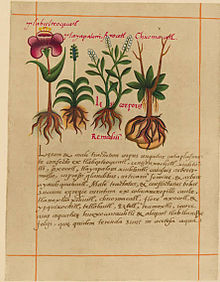- Libellus de Medicinalibus Indorum Herbis
-
The Libellus de Medicinalibus Indorum Herbis (Latin for "Little Book of the Medicinal Herbs of the Indians") is an Aztec herbal manuscript, describing the medicinal properties of various plants used by the Aztecs. It was translated into Latin by Juan Badiano, from a Nahuatl original composed in the Colegio de Santa Cruz de Tlatelolco in 1552 by Martín de la Cruz that is no longer extant. The Libellus is also known as the Badianus Manuscript, after the translator; the Codex de la Cruz-Badiano, after both the original author and translator; and the Codex Barberini, after Cardinal Francesco Barberini, who had possession of the manuscript in the early 17th century.
Contents
History
In 1552 Jacobo de Grado, the friar in charge of the Convent of Tlatelolco and the College of Santa Cruz, had the herbal created and translated for Francisco de Mendoza, son of Antonio de Mendoza, the viceroy of New Spain. Mendoza sent the Latin manuscript to Spain, where it was deposited into the royal library. There it presumably remained until the early 17th century, when it somehow came into the possession of Diego de Cortavila y Sanabria, pharmacist to King Philip IV. From Cortavila it travelled to the Italian Cardinal Francesco Barberini, possibly via intermediate owners. The manuscript remained in the Barberini library until 1902, when the Barberini library became part of the Vatican Library, and the manuscript along with it. Finally, in 1990 — over four centuries after it was sent to Spain — Pope John Paul II returned the Libellus to Mexico, and it is now in the library of the National Institute of Anthropology and History in Mexico City.
A copy was made in the 17th century by Cassiano dal Pozzo, the secretary of Cardinal Barberini. Dal Pozzo's collection, called his Museo Cartaceo ("Papers Museum"), was sold by his heirs to Pope Clement XI, who sold it to his nephew, Cardinal Alessandro Albani, who himself sold it to King George III in 1762. Dal Pozzo's copy is now part of the Royal Library, Windsor. Another copy may have been made by Francesco de' Stelluti, but is now lost. Dal Pozzo and de' Stelluti were both members of the Accademia dei Lincei.
Translations
Year Language Title Translator Publisher 1939 English The De la Cruz-Badiano Aztec Herbal of 1552 William Gates The Maya Society 1940 English The Badianus Manuscript (Codex Barberini Latin 241): An Aztec Herbal of 1552 Emily Walcott Emmart The Johns Hopkins Press 1952 Spanish Libellus de Medicinalibus Indorum Herbis: El manuscrito pictórico mexicano-latino de Martín de la Cruz y Juan Badiano de 1552 Francisco Guerra Editorial Vargas Rea y El Diario Español 1964, 1991 Spanish Libellus de medicinalibus indorum herbis: Manuscrito Azteca de 1552: versión Española con estudios y comentarios por diversos autores (ISBN 968-16-3607-4) Instituto Mexicano del Seguro Social 2000 English An Aztec Herbal: The Classic Codex of 1552 (ISBN 0-486-41130-3) William Gates Dover (republication of 1939 edition) See also
- Aztec entheogenic complex
References
- Byland, Bruce (2000). "Introduction to the Dover Edition". An Aztec Herbal: The Classic Codex of 1552. Mineola, New York: Dover. iii–xiii.
Categories:- 1552 books
- Mesoamerican historical documents
- Aztec society
- Latin words and phrases
- Medical books
- Mesoamerican medicine
- House of Barberini
Wikimedia Foundation. 2010.

